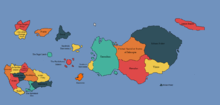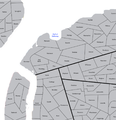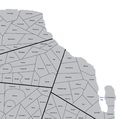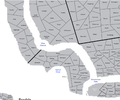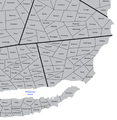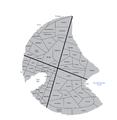Nation/Hackleberry Islands
| This page is a work in progress by its author(s) and should not be considered final. |
| The Federal Republic of the Hackleberry Islands | |||
|---|---|---|---|
|
|||
| Motto: "Pacem, prosperitatis, libertas" | |||
| Anthem: A Brave New World | |||
The Hackleberry Islands, located in the center of the region;
|
|||
| Capital and largest city | Neptune City | ||
| Official languages | English, French | ||
| Recognised national languages | Armenian, Irish, Scottish Gaelic | ||
| Ethnic groups | Westminister Hacklet, Sandwichian, Sprite, Tideland, Crescent French, Keystonian, Cortallian, Samukanian | ||
| Demonym | Hacklet (official), Islander | ||
| Government | Federal presidential republic | ||
| - | President | David Hackett | |
| - | Vice President | Sarkis Kazarian | |
| - | Head of the Senate | William Barrows (former President) | |
| - | Head of the Roll House | Paul Oster | |
| - | Head of the Courts | Thomas Wheeler | |
| Legislature | National Assembly | ||
| - | Upper house | Senate | |
| - | Lower house | Roll House | |
| History | |||
| - | First discovered by Sandwichian English; | January 21st, 1585 | |
| - | Independence Agreement reached; | March 27th, 1799 | |
| - | National Founding Document Signed; | July 26, 1799 | |
| Area | |||
| - | Total | 170,000 km2 65,000 sq mi |
|
| - | Water (%) | 48% | |
| Population | |||
| - | 2014 estimate | 65,000,000 (NS Actual: 4,550,000,000) (4th in Kennan) | |
| HDI (2014) | very high |
||
| Currency | Berry (ß) |
||
| Time zone | Eastern Standard Time (UTC-5) | ||
| Date format | mm ˘ dd ˘ yyyy | ||
| Drives on the | right | ||
| Calling code | +232 | ||
| Internet TLD | .hi | ||
The Hackleberry Islands, officially designated as The Federal Republic of the Hackleberry Islands, is a country located west of the mainland of Kennan, located to the south of the Sandwich Territories, to the west of Samukan, to the north of Kazaristan, and to the east of The Bagel Lands and the continent of Kennan Minor. The nation is an island archipelago consisting of 5 islands, as well as multiple smaller ones.
The nation was formed in 1799 after citizens who had migrated from the nearby Sandwich Territories wanted to govern themselves due to a rather distanced relationship with the Sandwichians and a very strong sense nationalism. The Sandwich Territories allowed the citizens independence, and the Hackleberry Islands was founded on July 26th, 1799. The government was founded under Jean-Louis Blueberry, the primary lobbyist for independence, and the political system was established shortly after, the official name of the country being related to him. The Hackleberry Islands and the Sandwich Territories have since remained very close allies and signed a permanent peace treaty in 1869. The channel located between the two nations has since been named "The Sandberry Channel".
The nation, like neighboring Samukan, is a federal presidential republic, headed by the legislative Hackleberry Islands Senate & Roll House, the Judicial System, and the National Council. The government is headed in Neptune City, the capital and largest city in the nation. The currency is the berry (ß), and is worth roughly USD $1.29, EUR €0.95, or GBP £0.76. The economic system is a socialist type, and mildly regulated by the government. Taxation is at 10% of citizens' yearly income; The government allows the people to choose where their taxes go. A large amount goes to education, environmental services, healthcare, and public services, with lesser amounts going to industry and manufacturing.
The Hackleberry Islands have an extremely varied climate over an area no more than 300 miles from the Sandberry Channel to the southern tip of the Tide Isles (north to south). The northern two islands and the majority of the Westminster Island (the central island) are relatively temperate, while the southern islands and a minority of Westminster Island are warmer, almost subtropical. While the exact cause of this is unknown, many scientists agree that the Hackleberry Islands, as well as its neighbor The Bagel Lands are split by warm/cool ocean currents and warm/cool jet streams. This dramatic climate difference means that the Hackleberry Islands and the Bagel Lands are the epicenters of some of the most violent hurricanes and tropical storms in Kennan.
Culturally, the Hackleberry Islands have been known to other nations to be overall extremely courteous and friendly, known to some as "The Canada of Kennan", and is known for being pacifist, not having declared war once in the nation's history. This pacifist nature often means that the Hackleberry Islands are often targeted for terror attacks and regional conflicts. Yet, the nation's diplomacy and pacifist peace-seeking nature has led to what has been coined as "The Hackleberry Effect", meaning that the majority of nations in Kennan will aid the Hackleberry Islands in the event of a conflict or negative situation. Thus, there are not many nations who are public enemies with the Hackleberry Islands, if there are any at all. The nation holds a large amount of influence in Kennan's government, often being assigned the Secretary Nation of Human Rights in regional politics. This large influence and peaceful nature has established the nation as Kennan's major protective power, acting as the voice of reason between nations who have turbulent political relations, such as Samukan and Ethan Foley. The Hackleberry Islands have also followed the footsteps of the Sandwich Territories in pursuing foreign relations with other nations in related regions, such as the Sandwich Territories in the South Pacific. In this aspect, the Hackleberry Islands has been one of the de facto ambassadors to smaller regions from Kennan, such as The United Coalition.
Contents
History
Prehistoric Era
While the Hackleberry Islands as a nation was established in 1799, some certain information is known about past civilizations located in the modern day nation. Humans are believed to have migrated to Kennan thousands of years ago. Human activity has been traced to modern day Ethan Foley, Samukan, and the Hackleberry Islands. Nomadic European tribes are believed to have made a presence in the modern day Hackleberry Islands. Not much is known in detail about these people, as recorded history began around 200 A.D. It is known that these people are of Anglo-Saxon descent, and that each of the modern day islands developed its own form of society.
Founding
During the second half of the 16th century, Sandwichian explorers were colonizing islands and undisputed territories to add land and influence to the newly christened Commonwealth of the Sandwich Territories. The islands consisting of the modern day Hackleberry Islands were some of the first to be colonized. As Sandwichian sailors stepped foot on Island soil, they were met by many natives from different
Trident Pact
During World War II, the Hackleberry Islands and Bagel Lands assisted the Allies in naval, land, and air battles in the European Theater. Both the Hackleberry Islands and Bagel Lands operated on a rather symbiotic military relationship; The Hackleberry Islands had a very powerful naval and air force, while the Bagel Lands had a formidable army and land based armed force. The Hackleberry Islands were also suppliers of the materials necessary for military aircraft, tanks, and ships, while the Bagel Lands manufactured the equipment and vehicles. On March 27th, 1943, the Bagel Lands and the Hackleberry Islands, under the command of Premier Paul Bagel I and President Satoru Arumaka respectively, signed the Trident Pact; A military alliance which acted as a peace treaty, economic agreement, and incorporated each nation's defense forces to coordinate between the two nations.
The Hadron Federation and Spriteland Isles were enlisted in the Trident Pact on December 22th, 1943. The Spriteland Isles provided the raw materials for the remainder of the war, and the Hadron Federation began developing the blueprints for the new weapons for the war. After the war ended however, the nations of the Trident Pact remained together, and have remained together to the present.
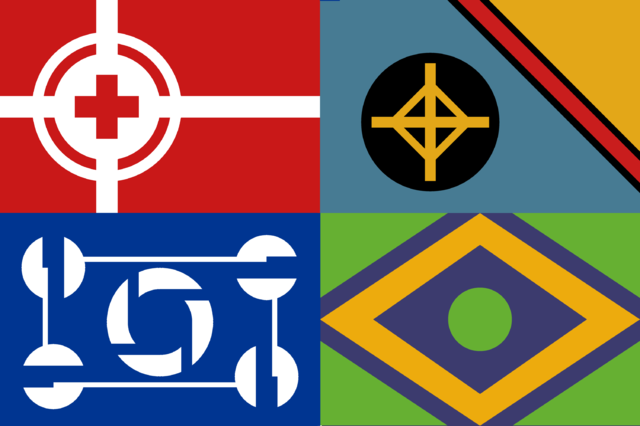
The following nations in order clockwise: The Bagel Lands, The Spriteland Isles, The Hadron Federation, and the Hackleberry Islands.
"The Oil Crisis"
Around the time of the counterculture movement in the 1960s, citizens began to notice the significant drop in air quality in major cities such as St. Petersburg (The nation's largest industrial center.), which had been shrouded in smog due to heavy air pollution from unregulated manufacturing centers, and automobiles. These pollution records were never documented after World War II, due to the necessity of supplying food and supplies to the Allied forces, and to the refugees of Nazi occupied territory. And during the 1950s, the nation began to trade with nations outside of Kennan, resulting in a massive increase in manufacturing items.
In 1967, records began to indicate rising respiratory and cardiovascular diseases, such as lung cancer, tuberculosis, and asthma in the population inside major manufacturing cities such as St. Petersburg and Newton. This also deterred tourism, perhaps the nation's biggest economic resource, to these cities. When the government began to highly regulate factories to lower their carbon footprint, the economy experienced detriment as a result. All of this resulted in an economic depression that slowly began to shut down the national infrastructure. In November of 1967, the nation began to lose the ability to purchase fossil fuels from other nations. This was colloquially known as "The Oil Crisis".
The Oil Crisis slowed down the nation's economy, and the infrastructure began to collapse. However, in a very bizarre way, chaos and anarchy did not ensue due to the loss of oil. Electricity was already in production from green energy sources such as wind turbines. Instead, Hacklets adapted. Car usage slowed and stalled. Public transportation became common for many people living in suburban and urban areas resulting in the creation of the NCTA (Neptune City Transportation Association). The reserve oil used to power public transportation was enough to keep the infrastructure of the economy from total collapse. In cities, many people also took to bicycling and walking.
As a result, many of the current habits adopted by current Hacklets today were created as a result of the Oil Crisis, such as massive support for public transit, a high emphasis on the environment, and the usage of carpooling. Today, many people still walk and utilize bicycles, which helped decrease the nations obesity level to its current percentile today, at 5%. Many people in metropolis areas utilize subway and bus networks heavily, while in suburban and rural areas utilize commuter trains. This also gave rise to the Hackleberry Islands' largest export, saved the economy from a complete crash, and became Kennan's major energy source and fuel: Biofuel.
Biofuel
While this use of public transit and disuse of personal transport greatly increased the longevity of the oil reserves available to the Hackleberry Islands, oil was not a permanent resource; It would last until 1971, according to local projections in 1968. Fuel centers and scientists frantically raced to find an alternative. Organic compounds always remained part of every solution proposed; Olive oil, wind up batteries, and even solid human waste were proposed.
in April of 1968, aspiring biologist Wilfred Intamin presented a biofuel of liquefied biomass compounds and processed organic waste. The fuel, if it were to replace gasoline, would greatly decrease organic waste buildup, would be completely renewable, and would be an additional trade item if Kennan followed suit with biofuel; There would be surplus to export as long as the population didn't pass 110 million (The population at the time was 52 million.). Immediately, biofuel became a household name, as people thought the recession was over. Intamin, and all the scientists in his development group were contacted by the government, and the fuel began testing. It was approved by the Department of the Environment, and the Department of Economics, as well as approved for safety. Current automobile engines at the time were designed to run on gasoline, yet strangely somewhat compatible with the new fuel.
Biofuel was officially introduced to the Hackleberry Islands on June 27th, 1968. Gas stations began to convert to biofuel as the new fuel grew in demand. The economy sharply rose, and gained value as the Hackleberry Islands' infrastructure reformed. Intamin released the instructions for biofuel, and private contractors and companies who had the resources to produce it began to produce the energy. The government would regulate certain aspects of the new fuel, however. The composition had to be near-identical to Intamin's design to avoid any problems with new engines, and the companies had to have a record of their agreements with waste companies in order to produce the fuel.
In July of 1968, the government of the Sandwich Territories contacted the Hackleberry Islands for a trade agreement involving biofuel. With Intamin's consent, the fuel and engine plans were exported to the Sandwich Territories as it began to slowly adapt from fossil fuels. A total transition was reached by 1974. It was later exported to Samukan and Cortal in an agreement reached in January of 1969, and with the Trident Pact nations in March of 1969.
Since then, biofuel has become a staple of renewable green energy in Kennan and beyond. Reducing waste output to hundreds of percentiles less than before it existed, biofuel has proven to be extremely beneficial to the Hackleberry Islands' economy. It has also been refined drastically to be less effective on the environment, and to utilize more waste. Today's modern biofuel has seen many upgrades to what was unveiled in 1968, which by today's standards would have been regarded as "crude". Wilfred Intamin himself has overseen its entire progress, and currently is one of the nation's most known and revered citizens. However, biofuel had a few negative impacts. It destroyed the Hackleberry Islands' manufacturing and industrial sectors, resulting in a reliance on other nations to process the raw materials for common everyday items, such as The Soodean Imperium and the Consolidate Nations Alliance. It also resulted in a strange transition phase of fuels as gasoline engines were modified greatly to run on biofuel. The biofuel engines slowly made their transition by being installed into car models starting in 1970, and those who had older models would eventually need to get their engines modified to run on the new fuel. This resulted in cars on the road which could not refuel if they needed gasoline. However, most vehicles were registered with biofuel engines by 1972. Very few gasoline stations exist today, either for the purpose of nostalgia or for those who kept their gasoline engines inside their older vehicles.
The Great War of Kennan & Invasion of the Islands
In 1997, Ethan Foley founded the Kennan Union alongside the People's Republic of Wilder, a military organization. Tensions between Ethan Foley and Samukan rose as the second millennium approached. Tensions came to a head in 2001 when Ethan Foley and the People's Republic of Wilder declared war on Samukan and the United Socialist States of Jakeopia, who had formed the Western Kennan alliance. The Hackleberry Islands stayed neutral throughout the entire war, yet assisted refugees and those seeking political asylum. Very few soldiers from the Hackleberry Islands were killed in action during this time period, as most were regarded as medical soldiers.
In 2003, Dictator Ryan Wilder of the People's Republic of Wilder (PRW) began to turn his attention towards the Hackleberry Islands and the Sandwich Territories. Although neither of the two nations had done anything to harm PRW, Wilder began to pressure both nations into joining the Kennan Union, because of the dictator's annoyance at the neutral stance of both nations. (The exact reason why Dictator Wilder was annoyed with the Hackleberry Islands and Sandwich Territories' neutrality is unknown.) On October 12th, 2003, Wilder sent President Hackett an ultimatum quoted;
"I have reconsidered. I shall send 300k to the Hackleberry Islands to crush them before an uprising... Unless you agree to come out of neutrality and join the Union."
After the invasion attempt by PRW, the Hackleberry Islands were not attacked again, and stayed safe for the remainder of the war, continuing to act as a medical force and a protective power between belligerents.
Geographic Information
The Hackleberry Islands is an island archipelago composed of five major islands: Westminster Island, Crescent Island, the Keystone Mountains, the Tide Isles, and Sprite Island. The nation is located west of the mainland of Kennan, located to the south of the Sandwich Territories, to the west of Samukan, to the north of Kazaristan, and to the east of The Bagel Lands and the small continent of Kennan Minor.
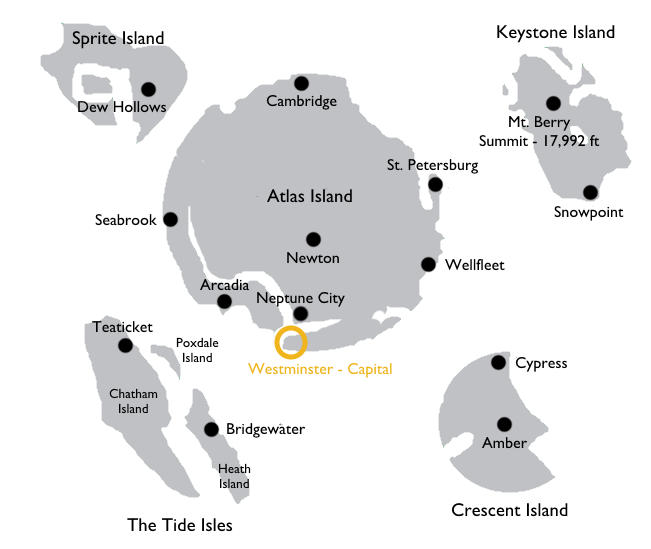
Westminister Island
Westminster Island is the largest island, in the center of the archipelago. Regarded as the main island, it generally resembles a circle, has a diameter of 250 kilometers from its northernmost city, Cambridge, to the southernmost city, Neptune City, the capital. It has a predominantly Sandwichian English population. Westminster Island is best known for being a communication, transportation, and shipping hub of Kennan. Aside from trade, the island has a large technological industry, and produces the majority of the Islands' energy. The western and southern coasts of Westminster Island are separated by a contiguous channel, Whitecross Sound in the south, and West Channel in the west, which appears to resemble large rivers from space. The southern portion of the island has a temperate climate, with warm summers at 70°F (21°C), and cool/cold winters, generally ranging at 25°F (-3°C). Due to the presence of the Keystone Mountains, the northeastern area of Westminster Island has cooler summers at 60°F (15°C), and similar winter temperatures at 20°F. Many areas contain deciduous forests, coniferous forests, lakes & streams, and marshes nearby some coastal areas. Grasslands and coniferous forests are also located inland. Glacial rock formations & springs densely populate the land, due to the large amount of ground water in the ecosystem.
- Butler Library - 1000px - AC.jpg
Senate Arena, Neptune City, Westminister Island
Keystone Island
Keystone Island is an island consumed by a mountain range that rises above sea level, due to volcanic activity that occurred about 2 million years ago. The climate consists of the Keystone Mountain Range, with various deciduous forests near sea levels, and plateaus at higher elevations. While populated near the coastline facing Westminster Island, the rest of the island is sparsely populated, with the exception for scientists nearby the range, and native peoples that have survived in the mountain range for hundreds of years. The temperatures at sea level very rarely rise above 50°F (10°C) in summers. In winter, the temperature averages at sea level at 10°F (-12°C). However, temperatures in all seasons can lower to levels that cannot sustain human life, depending on the season. Several mountains reach thousands of feet into the sky, such as Mt. Berry, the tallest peak in the nation, reaching to 17,992 ft (5484 m). While Mt. Berry and the surrounding mountains are dormant, many erupt in a calm flow on a daily basis into the sea, providing spectacular shows for boaters. Geysers and hot springs are also very common sights.
- GeysirEruptionNear.jpg
Highland Geyser, Inverness, Keystone Island
- Reykjavík séð úr Hallgrímskirkju.jpeg
Shetland, Keystone Island
Crescent Island
Crescent Island is named for its shape - It resembles a face in a half moon. Culturally, the island is split in half between the English speaking northern half, and the French speaking southern half. Economically, it's the center of agriculture of Hackleberry. The land consists of grasslands, and marshes. Much of the land is used for farming: 38% of the land is owned for farmland. Orchards, vineyards, stables, ranches, dairy farms, and plantations dot the landscape. Many cities dot the coast, allowing materials to be sent to the other islands for consumption and further distribution. Urban and suburban areas exist in average quantities, but with large amounts of farming settlements. Summers are warm at 70°F (21°C), and winters are cool at 40°F (4°C). Snow, while not a rare occurrence, does not occur as often as islands to its north. It does receive a lot of precipitate in general, most commonly rain.
The Tide Isles
The Tide Isles are a miniature archipelago of three small sized islands: Chatham, Heath, and Poxdale. The islands are grouped together into one title: The Tide Isles. Best known for its tourism and sea-faring population, the Tide Isles have the second highest population of the nation, and are thickly settled. All three islands have the same climate, similar to Crescent Island. Warm summers at 70°F (21°C) and cool winters at 40°F (4°C). The three islands have similar ecosystems: Deciduous forests and marine ecosystems cover the isles. Poxdale has a large marine ecosystem due to its small size, and harbor economy. Described as "Tropical, but not tropical", the Tide Isles are a popular tourist destination in all seasons, and are generally warmer than the other four islands. It also tends to receive less precipitation in general as well.
- Tower Bridge Sacramento edit.jpg
Sheraton, Heath Island, the Tide Isles
Sprite Island
Sprite Island is a smaller sized island that is located northwest of Westminster Island. It has warm-mild summers at 60°F (15°C) and cool winters at 40°F (4°C). Notorious for its mild weather and cooler temperatures, Sprite Island has an island inside it, which it surrounds. While unknown how this small island came to be, it's known as Derby. Sprite Island is best known for its historic and environmental value: Some areas of Derby have remained relatively preserved since the founding of the country in 1866, and some areas have not been touched by humans for years on the rest of the island. For this reason, some areas of Sprite Island are kept under the protection of the National Environmental Agency. It also consumes the least amount of energy of the 5 islands. The ecosystem of Sprite Island is a deciduous forest & coniferous forest mix.
- 26 swiatoinos.jpg
Cyrillic Mountains, Sprite Island Preservation Area, Sprite Island
Government & Politics
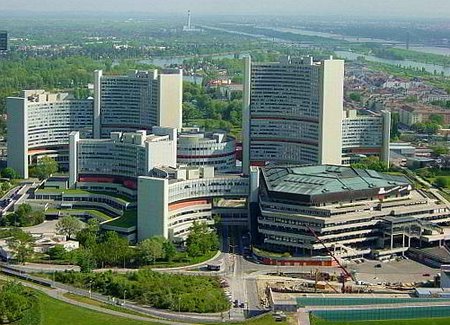
The National Complex, Federal District, Neptune City
The national government is split into four categories: The National Council, which forms the head of the government, the Senate, the legislative assembly utilized to create, modify, and pass national and international legislation, as well as perform major actions, the Roll House, the legislative assembly used to create, modify, pass, and enforce domestic legislation, and the Judicial Courts, utilized to enforce said legislation. All four groups work in tandem, with the leaders of the Senate and Roll House reporting to the National Council.
National Council
The National Council forms the head of the government, headed by the President of the Hackleberry Islands. The National Council acts as the passing force for legislation from the Roll House and the Senate, and is the center of foreign affairs and major national issues. It consists of the President, the Vice President, the heads of the Senate and Roll House, the Head of the Judicial System, the Secretariat of Government, the national ambassadors, other major government figures, and representatives from other nations if necessary. Normally
The National Council works in tandem with the other governmental groups. When the Roll House passes domestic legislation, the President must approve of said legislation. When the piece of legislation is greenlit by the National Council, the Roll House passes the legislation, and it is shortly put into effect. The Senate's legislation must have a majority approval rate by the National Council, due to its legislation having much more of an impact on national politics. The Judicial System must also report to the National Council, if necessary, to discuss the laws passed on occasion, and their possible consequences.
The National Council can also assume control of the nation during an emergency or disaster in which the four groups would not be able to act in time, such as in the events of the People's Republic of Wilder Invasion of 2003, or the heavy damage sustained from Hurricane Robinson. In this effect, the National Council can pass emergency legislation, make decisions quickly, and act as a continuation of government until order is restored, which it then hands powers back to the Senate, Roll House, and Judicial System.
One of the major jobs of the National Council is to represent the nation in foreign affairs. Ambassadors, as well as the heads of government, including the President and Secretary of Foreign Affairs, will travel to other allied nations and discuss trade agreements, alliances, and treaties. The President and the national ambassadors will also travel to the Kennan Regional Council Complex on Neutral Island to pass regional laws and perform emergency regional actions. The National Council also has the ability to create peace treaties and trade agreements without the approval of the Senate if necessary, (although most agreements are relayed to the Senate anyway).
Foreign Affairs
The Hackleberry Islands have experienced positive relations with most nations inside and outside of Kennan that have interacted with the nation.
Foreign Relations
Allies
The following nations are considered to be allies of the Hackleberry Islands, and have strong ties with each other:
- Sandwich Territories
- The Bagel Lands
- Samukan
- Cortal
- The Hadron Federation
- The Spriteland Isles
- Consolidate Nations Alliance
- The Soodean Imperium
- Nationalist Reichland
- United Tiberia
- Frache
Neutral Relations
The following nations have experienced no relations or neutral relations with the Hackleberry Islands, and are on peaceful terms. Many of these nations are trade partners:
- Ethan Foley
- PRW Ancestors
- The Azerian Empire
- United Solcialist States of Jakeopia
- Soviet New Ireland
- Soviet New Wales
- Canadian Louisiana
- Pantorrum
Enemies
There are very few public enemies of the Hackleberry Islands, and more often than not, these nations are commonly disliked by the region of Kennan entirely. As of current, the only enemies of the Hackleberry Islands are:
Trade Partners
The following nations have economic ties with the Hackleberry Islands, and trade with the nation:
- Sandwich Territories
- The Bagel Lands
- Samukan
- Cortal
- The Hadron Federation
- The Spriteland Isles
- Consolidate Nations Alliance
- The Soodean Imperium
- Ethan Foley
- PRW Ancestors
- Soviet New Ireland
- Soviet New Wales
- Pantorrum
Demographics
Languages
There are two official languages spoken in the Hackleberry Islands: English and French. English, the dominant language, is a first language of 85% of the population. The second dominant language, French, is spoken as a first language for 12% of the population. Less common languages include Armenian, Arabic, and other Celtic languages like Irish, Welsh, Cornish, and Scottish Gaelic. (For more information regarding languages and culture, see "Personal Traits & Characteristics" under Culture.)
| Language | First languages; | |
|---|---|---|
| English | 85% | |
| French | 12% | |
| Armenian | 1.2% | |
| Arabic | 1.0% | |
| Spanish | 0.4% | |
| Celtic Languages | 0.3% | |
| Other | 0.1% |
Religion
The Hackleberry Islands is home to a variety of different religions and beliefs. Historically, the majority of the first settlers from the English-descended Sandwich Territories were Protestant Christians. French settlers had a majority Islamic or Catholic Christian population. However, multiple other religions have since established themselves in the nation, like Judaism, Hinduism, and Buddhism; Cathedrals and churches are common in most towns today, and other places of worship like synagogues and mosques are common in larger areas. Atheism and agnosticism are also common.
| Religion | Following percentage; | |
|---|---|---|
| Christianity | 40% | |
| Agnosticism | 24% | |
| Atheism | 15% | |
| Islam | 10% | |
| Judaism | 6% | |
| Buddhism | 2% | |
| Other | 3% |
Defense
The Hackleberry Islands have a moderately large military force to defend against invasion and terror attacks. Currently, as of 2014, there are 750,000 people enrolled in the armed forces, a rather high percentage compared to the 65 million citizens inhabiting the islands. The military is coordinated with the Trident Pact, meaning that the nation coordinates with the Bagel Lands, Spriteland Isles, and Hadron Federation.
- 35% are in the Air Force.
- 35% are in the Naval Forces
- 15% are in the National Guard.
- 10% are in the Army.
- 5% are in specialized forces.
Infrastructure
Transportation
The Hackleberry Islands, due to the small size of the nation, and due to the Oil Crisis, has an increased reliance on public transportation.
Culture
Rich in culture and demographically diverse, the Hackleberry Islands is perhaps notorious for its culture and national values, and is often stereotyped based of of them.
Personal Traits & Characteristics
Hacklets have a few general characteristics and values that gives them a distinct identity.
Hacklets are notoriously known to be friendly, polite, and courteous to each other, and foreigners. These values of hospitality were instilled during the time that the Hackleberry Islands were still under Sandwichian control. Hospitality between farmers and merchants became the standard for business practices, as well as formal and informal life. Eventually, this adopted characteristic became the norm for social interaction. Hacklets are expected to be courteous to others, and are often chastised by others Hacklets if they aren't. This outright friendliness occasionally alienates some foreigners, who are more used to reserved societies - However, the majority of visitors report that they liked the friendly atmosphere portrayed by most Hacklets.
Hacklet society is also notorious for equality among all of its citizens. These standards were also imposed during the colonial era of the nation. The standards of equality often bend religions and other cultural values to fit the template for Hacklet society. For example, many French Hacklets practice Islam. Normally, women are expected to dress conservatively and obey sharia law. However, when French colonists arrived and assimilated into the Sandwichian-English majority of the population, a syncretic form of Islam arose, known as Crescent Islam (الهلال الإسلام). Women are not expected to cover their heads or dress conservatively by force, and share all of the same rights as men. Marriages are performed by choice and consent of both spouses.
While an overwhelming majority of Hacklets speak English, the country is officially bilingual, with a large French speaking population on Crescent Island. Hacklets who know one language are expected to be able to carry out a simple conversation in the other. Most English-speaking Hacklets can communicate with the French population, and vice versa. Hacklets are expected to be able to communicate in a second language to a basic extent, and while the majority is either English-French or French-English, a few other languages persist. Some French Hacklets are proficient in Arabic, due to their connection to Islamic practices. Many Hacklets also speak a form of Armenian, which resulted from the influx of refugees who escaped the Armenian Genocide. And while rarer than the two other groups, some Hacklets can speak Celtic languages, such as Irish, Welsh, Cornish, and Scottish Gaelic.
Media
Film and television in the Hackleberry Islands are heavily funded and supported by citizens. The government funds the 6 Hackleberry News Network (HNN) TV channels, and provides them with tax funding as a public service. Aside from their intended purpose of distributing information such as the news and weather, HNN channels also provide programming for entertainment purposes. Aside from the six HNN channels, there are multiple privately funded TV networks.

